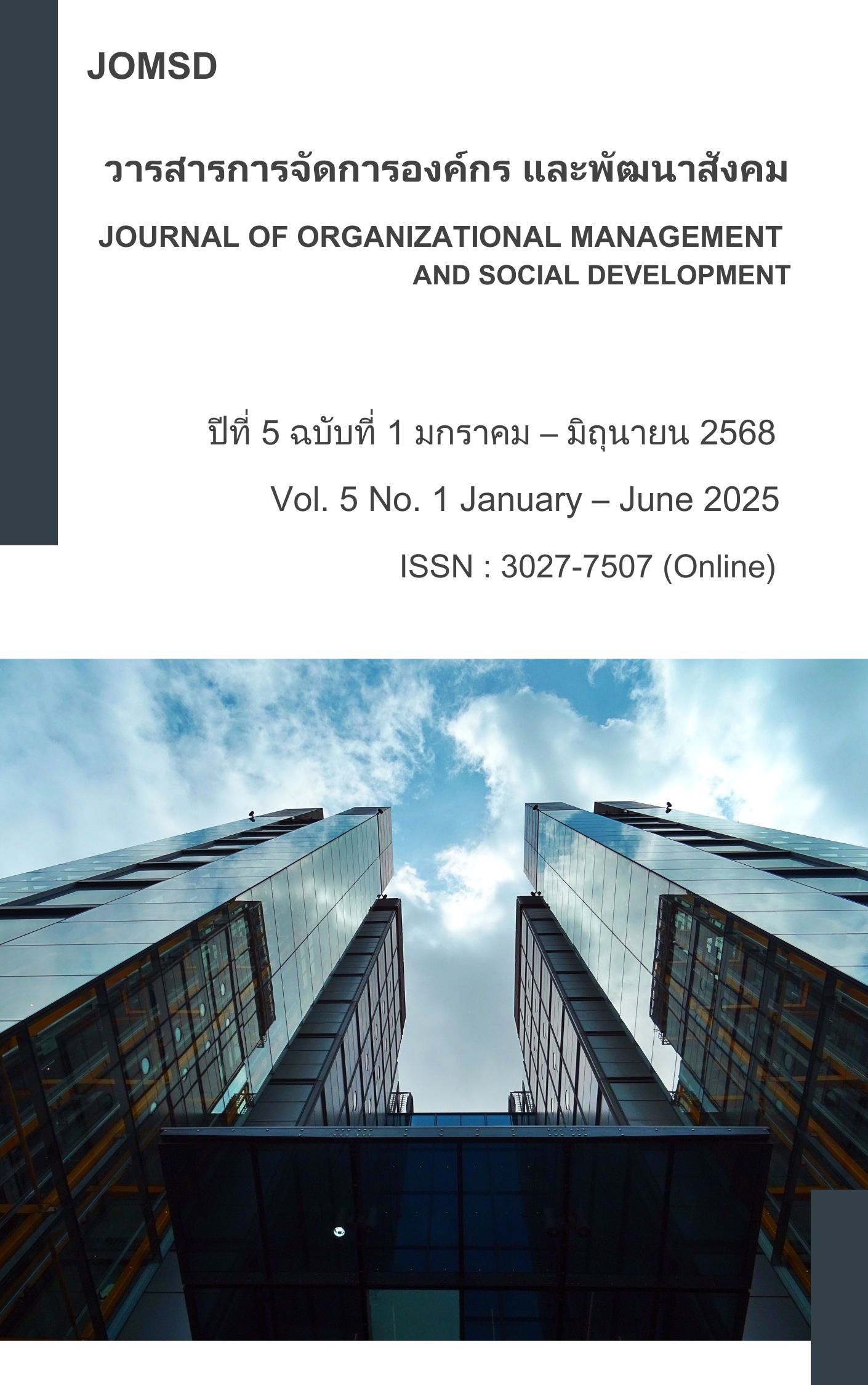The Development Approach for the Potential of Miang Kham Sweet Shrimp Paste (Ruea Thai Brand) Products by the Ban Krasa Chao Seafood Processing Community Enterprise, Ban Bo Subdistrict, Mueang District, Samut Sakhon Province
Main Article Content
Abstract
This research aims to 1) examine the factors influencing consumer purchasing decisions for Nam Mieng Kham Kaphi Wan (Thai Ruea Brand), 2) propose strategies to enhance the product’s potential in terms of quality, marketing, and branding, and 3) assess the impact of product development on community enterprises and the local community. The study employed a mixed-method approach, collecting data from three main groups: 30 community enterprise members, 400 consumers, with an additional 400 participants from community enterprises, and 5 experts. Statistical tools used included mean, standard deviation, percentage, Pearson correlation, multiple regression analysis, and pre-post comparison to assess the effectiveness of product development. The results revealed that: 1) The most influential factor in purchasing decisions was product quality, followed by price, distribution channels, and marketing promotion. Consumers emphasized taste, freshness, and overall value, while effective promotional activities and accessible distribution encouraged repeat purchases. 2) Product development should focus on enhancing quality, implementing digital marketing strategies, and building a strong brand identity through storytelling. Integrating online channels and culturally inspired packaging designs can strengthen brand recognition among consumers. 3) The impact evaluation showed a significant increase in sales and income among enterprise members, along with improved resource management and stronger collaboration within the community. Knowledge sharing and a sense of pride in local wisdom were fostered, demonstrating the comprehensive benefits of a systematic development approach that supports both economic growth and social sustainability.
Article Details
References
กรมส่งเสริมอุตสาหกรรม. (2566). รายงานผลการส่งเสริมและพัฒนาอุตสาหกรรมระดับชุมชน ประจำปีงบประมาณ พ.ศ. 2566. สืบค้นจาก https://www.dip.go.th.
แครีน ริเกอ. (2562). ปัจจัยทางการตลาดที่มีผลต่อการเลือกซื้อสินค้าของผู้บริโภคผ่านแอพพลิเคชั่น Shopee ในเขตเมืองพัทยา. (บริหารธุรกิจมหาบัณฑิต, มหาวิทยาลัยรามคำแหง).
ทัศนีย์ พรีชวงษ์ และพัชรี ขวัญสนิท. (2021). อุปสรรคและกลยุทธ์ทางการตลาดในการส่งเสริมผลิตภัณฑ์อาหารท้องถิ่นในประเทศไทย. วารสารการพัฒนาชุมชนและความยั่งยืน, 17(2), 89-102.
พระไพรวัลย์ กตทีโป, พระทวีพงษ์ ลอยมา, ออมสิน ตุ้มทอง และพระปรัชญา ชยวุฑฺโฒ. (2566). การพัฒนาเศรษฐกิจชุมชนอย่างยั่งยืนบนพื้นฐานภูมิปัญญาท้องถิ่น ตามแนวทางเศรษฐกิจพอเพียง บ้านโพนครก ตำบลโพนครก อำเภอท่าตูม จังหวัดสุรินทร์. วารสารการจัดการองค์กร และพัฒนาสังคม, 3(2), 1–12.
พิชิต ศรีเจริญ. (2564). การพัฒนาโลโก้และสร้างแบรนด์ผลิตภัณฑ์ชุมชน: กรณีศึกษาผลิตภัณฑ์น้ำพริกปลาร้า ตำบลน้ำสอง อำเภอพยุหะคีรี จังหวัดนครสวรรค์. วารสารการพัฒนาอย่างยั่งยืนทางวิชาการ, 3(3), 37-48.
รัชนก ปัญญาสุพัฒน์, ชัยวิชญ์ ม่วงหมี และนฤมล สุ่นสวัสดิ์. (2567). รูปแบบความตั้งใจในการเป็นผู้ประกอบการของนักศึกษา มหาวิทยาลัยราชภัฏ ในยุคประเทศไทย 4.0. วารสารวิชาการเครือข่ายบัณฑิตศึกษามหาวิทยาลัยราชภัฏภาคเหนือ, 14(1), 52-70
ลลิตา พิมทา และ รักษดาวัลย์ ศิริตาคำ. (2021). การพัฒนาผลิตภัณฑ์จากภูมิปัญญาท้องถิ่นเพื่อเพิ่มประสิทธิภาพทางการจัดการชุมชนอย่างยั่งยืนของชุมชนบ้านมะยาง อำเภอธวัชบุรี จังหวัดร้อยเอ็ด. วารสารการพัฒนาชุมชนและคุณภาพชีวิต, 9(3), 465–473.
วิไลวรรณ อินทรักษ์. (2565). ภูมิปัญญาท้องถิ่นกับการพัฒนาผลิตภัณฑ์อาหารชุมชน. วารสารวิถีชนกับการพัฒนา, 10(1), 45-58.
สำนักงานสภาพัฒนาการเศรษฐกิจและสังคมแห่งชาติ. (2566). รายงานภาวะเศรษฐกิจและสังคมของครัวเรือนไตรมาสที่ 4 ปี 2566. สืบค้นจาก https://www.nesdc.go.th/.
สุระเดช ไชยตอกเกี้ย. (2566). ปัจจัยที่มีผลต่อพฤติกรรมการบริโภคอาหารของวัยผู้ใหญ่ภาคตะวันออกเฉียงเหนือ. วารสารมหาวิทยาลัยราชภัฏเลย, 18(1), 68–78.
Aaker, D. A. (1996). Building strong brands. California: The Free Press.
Barney, J. (1991). Firm resources and sustained competitive advantage. Journal of Management, 17(1), 99–120.
Brown, T. (2021). Cultural identity and consumer behavior towards traditional food products: A study on value perception and price sensitivity. Journal of Consumer Research and Marketing, 28(3), 115–130.
Chaffey, D., & Smith, P. R. (2017). Digital marketing excellence: Planning, optimizing and integrating online marketing. (5th ed.). Oxfordshire: Routledge.
Chesamae, A., & Gadmeang, Y. (2021). The Development of packaging and branding for community products to link the cultural tourism of the Puranawas community, Thawi Watthana District, Bangkok. Journal of Humanities and Social Sciences Thonburi University, 15(2), 79–90.
Choo, H. J., Lee, H. K., & Xie, J. (2022). Consumers' cultural identity under globalization: Vietnamese consumers' global and national identities and their cross-cultural consumption. Asia Pacific Journal of Marketing and Logistics, 35(5), 1052-1074.
Cochran, W. G. (1977). Sampling techniques. (3rd ed.). New Jersey: John Wiley & Sons.
Creswell, J. W. (2014). Research Design: Qualitative, Quantitative, and Mixed Methods Approaches. (4th ed.). Washington DC: Sage.
Garvin, D. A. (1987). Competing on the eight dimensions of quality. Harvard Business Review, 65(6), 101–109.
Green, M. C., & Brock, T. C. (2000). The role of transportation in the persuasiveness of public narratives. Journal of Personality and Social Psychology, 79(5), 701–721.
Hong, J. H., Yang, J., Wooldridge, B. R., & Bhappu, A. D. (2021). Sharing consumers’ brand storytelling: Influence of consumers’ storytelling on brand attitude via emotions and cognitions. Journal of Product & Brand Management, 30(1), 1–14.
Karaste, M. (2025). Artisans in the digital world: Building brand awareness of small artisan businesses in digital platforms. (Master’s thesis, Lapland University of Applied Sciences).
Ko, J.-H., & Jeon, H.-M. (2024). The Impact of Eco-Friendly Practices on Generation Z’s Green Image, Brand Attachment, Brand Advocacy, and Brand Loyalty in Coffee Shop. Sustainability. 16(8), 3126.
Kotler, P., & Keller, K. L. (2021). Marketing management. (16th ed.). London: Pearson.
Kvale, S., & Brinkmann, S. (2009). Interviews: Learning the Craft of Qualitative Research Interviewing (2nd ed.). Washington DC: Sage.
Lestari, F., Dali, M. M., & Che-Ha, N. (2023). Local identity consideration in maintaining place branding sustainability (The case of Indonesia). Journal of Tourism, Hospitality and Environment Management (JTHEM), 8(2), 45-60.
Muangmee, C. (2021). Effects of Facebook advertising on sustainable brand loyalty and growth: case of Thai start-up businesses. Transnational Corporations Review, 15(3), 60-71.
Okonkwo, I., & Namkoisse, E. (2023). The role of influencer marketing in building authentic brand relationships online. Journal of Digital Marketing and Communication, 3(2), 81–90.
Pai, G. H. (2024). A comprehensive literature review on ‘Unpacking the influence of brand image on consumer purchasing decisions in the FMCG sector’. International Journal of Research Publication and Reviews, 5(1), 2384-2400.
Rovinelli, R. J., & Hambleton, R. K. (1977). On the use of content specialists in the assessment of criterion-referenced test item validity. Educational and Psychological Measurement, 37(2), 567–578.
Takyi, S. A., Owusu, J., Korsah, L. A., Issaka, A., Boateng, P. A., & Owusu-Yeboah, E. (2025). Investigating the effect of cultural influences and consumer behaviour on product branding in the manufacturing sector in Ghana. IOSR Journal of Business and Management, 27(1-3), 1–8.
Tavakol, M., & Dennick, R. (2011). Making sense of Cronbach’s alpha. International Journal of Medical Education, 2, 53–55.

